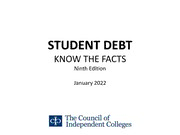
ERIC ED617415: Student Debt: Know the Facts. Ninth Edition PDF
Preview ERIC ED617415: Student Debt: Know the Facts. Ninth Edition
STUDENT DEBT KNOW THE FACTS Ninth Edition January 2022 The Issue With student loan debt reaching approximately $1.6 trillion, many 1 are concerned that student loans may be the next financial bubble to burst. CARES Act funding and U.S. Department of Education actions led to historically low levels of delinquency in 2020-2021. However, there is concern that issues will balloon as soon as governmental action and support are removed, which could lead to a great deal of uncertainty around student loan debt. What is the truth? This presentation presents the facts about college students’ indebtedness, relying on the most recent data available. 1. Federal Reserve Bank of New York Consumer Credit Panel/Equifax, Quarterly Report on Household Debt and Credit, Q3 2021. Council of Independent Colleges, January 2022 PERCEPTION FACT In 2021, only 7 percent of all Many students owe borrowers owed $100,000 or more than $100,000 more in student debt. In fact, when they graduate. the majority (75 percent) owe less than $40,000.1 Obtaining a college degree on average adds $1,000,000 to lifetime income.2 A private college graduate typically earns $53,8563 in the first year after graduation. 1. The College Board, Trends in Student Aid 2021, p. 40. 2. Georgetown University Center on Education and the Workforce, The College Payoff, Executive Summary, p. 2. 3. NACE, First Destinations for the Class of 2020, p. 9. Council of Independent Colleges, January 2022 Average Student Loan Debt per Bachelor’s Degree Recipient $25,000 $21,500 $21,700 $19,400 $20,000 $19,000 $17,400 $14,500 $14,500 $15,000 $12,900 $10,000 $5,000 $0 2004-2005 2009-2010 2014-2015 2019-2020 Public Four-Year Private Four-Year Source: The College Board, Trends in Student Aid2021, p.43. All totals are expressed in 2020 dollars. Council of Independent Colleges, January 2022 PERCEPTION FACT Nearly three out of ten students who recently graduated with a bachelor’s Because private degree from a four-year private college or university had no educational debt. colleges are so expensive, students For those with debt, the difference between the average debt levels for had to borrow an graduates of public versus private institutions is $4,500. Meanwhile, the average private college graduate’s starting unrealistic amount to salary is larger by $4,282.1 enroll in one. Also, 65 percent of private college graduates in 2015–2016 completed their degrees within four years or less; the average time to degree for private college graduates was seven months faster than their peers at public institutions.2 1. The College Board, Trends in Student Aid 2021, p. 43; NACE, First Destinations for the Class of 2020, p. 9. 2. U.S. Department of Education, National Center for Education Statistics, Baccalaureate and Beyond (B&B:16/17): A First Look at the Employment and Educational Experiences of College Graduates, 1 Year Later (NCES 2019-241). Council of Independent Colleges, January 2022 Distribution of Total Undergraduate Debt 0% 5% 10% 15% 20% 25% 30% 35% 40% 30% No Debt 37% 16% 10% Less than $10,000 13% 9% 12% $10,000-$19,999 13% 13% 18% $20,000-$29,999 15% 16% 12% $30,000-$39,999 10% 14% 18% $40,000 or more 12% 33% Private Four-Year Public Four-Year For-Profit Four-Year Source: U.S. Department of Education, National Center for Education Statistics, 2015–16 National Postsecondary Student Aid Study(NPSAS:16). Analysis by the Council of Independent Colleges. Council of Independent Colleges, January 2022 PERCEPTION FACT Most student loans are used Graduate students, who make up to pay for undergraduate about 16 percent of all postsecondary study. students, accounted for 47 percent of federal loans in 2020-2021 .1 Since 2011-2012, the share of undergraduate students borrowing federal student loans has declined every year to a low of 26 percent in 2020-2021.2 Only 15 percent of all federal undergraduate student loan disbursements in the 2019-2020 academic year were to students enrolled at CIC member colleges and universities.3 1. The College Board, Trends in Student Aid 2021, p. 39. 2. The College Board, Trends in Student Aid 2021, p. 40. 3. The College Board, Trends in Student Aid 2021, p. 39. Analysis by the Council of Independent Colleges Council of Independent Colleges, January 2022 Total Student Loan Disbursements by Sector AY 2019-2020 (in billions)* All Private $9.1 Public $18.8 For-Profit $31.0 Private (CIC) $12.2 $36.4 Private (Non-CIC) Only 15 percent of loans went to CIC students. *Includes both undergraduate and graduate loan disbursements. Council of Independent Colleges, January 2022 FACT PERCEPTION According to the most recent data, only Student loans are so 5.2 percent of private four-year college overwhelming that students defaulted on their loans compared with 7.9 percent of students many borrowers at for-profit four-year institutions.1 default. In reality, few students default on loans when enrolled in institutions granting at least a bachelor’s degree. Institutions that do not grant at least a bachelors degree have default rates at 10.8 percent1, on average. 1. U.S. Department of Education Office of Federal Student Aid Programs, Comparison of FY 2018 Official National Cohort Default Rates to Prior Two Official Cohort Default Rates (Calculated December 6, 2021). Council of Independent Colleges, January 2022 Three-Year Student Loan Cohort Default Rates (2014–2016) 10.0% 9.3% 9.3% 9.0% 8.4% 8.2% 7.9% 8.0% 7.0% 6.6% 6.3% 6.1% 6.0% 5.2% 5.0% 4.0% 3.0% 2.0% 1.0% 0.0% Fiscal Year 2016 Fiscal Year 2017 Fiscal Year 2018 Private Four-Year Public Four-Year For-Profit Four-Year Source: U.S. Department of Education Office of Federal Student Aid Programs, Comparison of FY 2016 Official National Cohort Default Rates to Prior Two Official Cohort Default Rates (Calculated August 4, 2019).Note: Default rates are for four-year institution attendees. Council of Independent Colleges, January 2022
